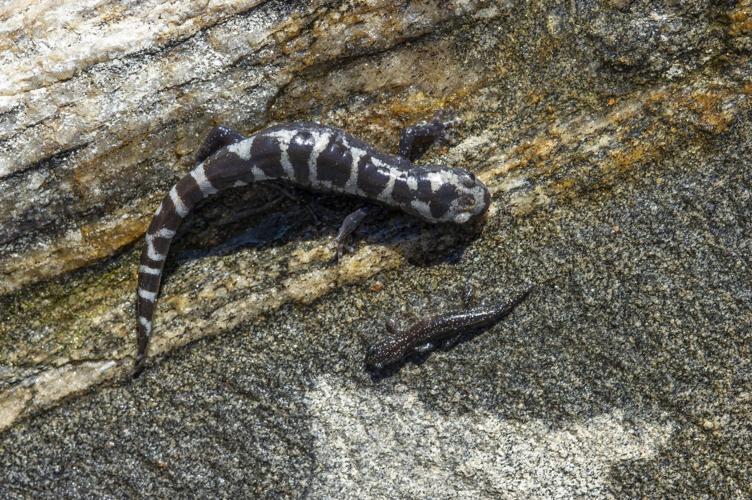Marbled Salamanders are rather stout-looking amphibians that live in moist woodlands where they burrow under leaves, logs and stones – which means they could be living in almost every Lake Martin yard. But if you don’t rake your leaves or spend time flipping over logs in the woods, you are not likely to run across your amphibious marbled neighbors.
Marbled Salamanders are native to the eastern and southeastern U.S. from New England to Illinois and south from Georgia to Texas; however, their range does not extend south into the warmer Florida peninsula. They are found throughout Alabama.
Adult Marbled Salamanders are about 4 inches long. Their whole bodies are black or dark gray with white, light gray or silver markings on their backs. Young Marbled Salamanders have white speckles on their backs and white striped toes; older salamanders develop larger light colored blotches and bands that cross their backs. Males are smaller than females, and during the fall breeding season – late autumn in our area – the bands on a male’s back become bright white.
These salamanders prefer damp woodlands close to streams, ponds and lakes, though they are sometimes found in dry areas that are close to wetlands. Unlike other closely related salamanders, Marbled Salamanders do not breed in water. Instead, these black and white salamanders breed in dry areas that hold water at times, like flood plains and vernal pools.
When it comes time to breed in autumn, Marbled Salamanders will migrate to those sites on rainy nights.
In fact, rainy fall nights are the most likely times to see a Marbled Salamander in the wild. Scientists studying these creatures at the University of Georgia put low fences around breeding sites that direct the salamanders toward buckets sunk into the ground. During the breeding migration, thousands of Marbled Salamanders will fall into the buckets, giving the scientists the opportunity to monitor the local population count.
Once the salamanders get to their breeding site, the male will begin circling a potential mate while waving his tail and waging his head and raising his body by standing tall on his legs. He will then leave a spermatophore – a small capsule of sperm – on the dry ground. The female will walk above the spermatophore and pick it up with her cloaca, fertilizing her eggs.
The females lay a mass of 50 to 100 round eggs under leaves in the low areas, and the eggs hatch out when rains fill the dried ponds and ditches. The mother salamander will stay with her clutch, protecting the eggs until the pool fills. If that doesn’t happen in the fall, the eggs can survive throughout the winter until spring rains trigger hatching.
Once the salamander larvae hatch, they quickly move to the top of the food chain in their temporary ponds, starting by eating tiny zooplankton and adding aquatic insect larvae, worms, snails and larger creatures as they grow. Marbled Salamander larvae look something like tadpoles with legs and big protruding bushy gills. Sometimes they consume other salamander larvae, including their own species. Here in the deep South, Marbled Salamander larvae grow very quickly and can morph into their adult land-based form in as little as two months. They can reach sexual maturity in roughly a year and a half.
Adult Marbled Salamanders are active carnivores, hunting and eating large amounts of insects, worms, spiders, snails and slugs and pretty much anything that moves that will fit into their mouths. These salamanders spend most of their days underground in burrows or tunnels or under logs or thick layers of leaves. They are most active at night, when they move above ground to hunt.
Marbled Salamanders are known as Ambystoma opacum to biologists. They are one of the smaller species in the Ambystomatidae family, which goes by the common name “mole salamanders,” a reference to their burrowing habit.
These salamanders live for about four years in the wild. That time could be cut short by nocturnal animals that prey on them, like raccoons, opossums, skunks, shrews, weasels, snakes and owls. Like many other salamanders, Marbled Salamanders do have poison glands on their tails, and some predators will eat the salamanders while leaving its tail untouched.
Some information for this article came from the North Carolina Wildlife Resource Commission, the Virginia Herpetological Society, The Savannah River Ecology Laboratory at the University of Georgia and the Animal Diversity Web at the University of Michigan.








